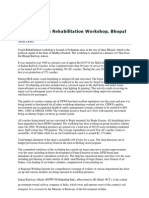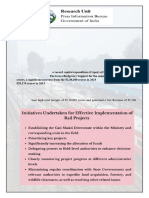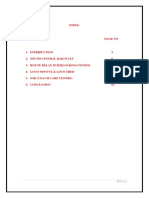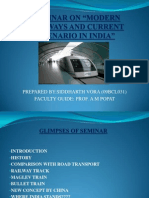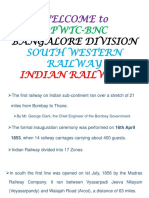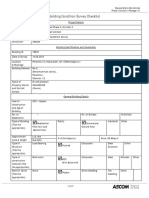0 ratings0% found this document useful (0 votes)
46 viewsNetwork: Tracks
Network: Tracks
Uploaded by
JayantYadavThe document summarizes the manufacturing and maintenance facilities of locomotives, rolling stock, and wheels/axles for the Indian Railways. It discusses the various factories that manufacture electric and diesel locomotives, coaches, and wheels across different states in India. It also mentions the network of repair depots and workshops that maintain the vast fleet of rolling stock.
Copyright:
© All Rights Reserved
Available Formats
Download as DOCX, PDF, TXT or read online from Scribd
Network: Tracks
Network: Tracks
Uploaded by
JayantYadav0 ratings0% found this document useful (0 votes)
46 views4 pagesThe document summarizes the manufacturing and maintenance facilities of locomotives, rolling stock, and wheels/axles for the Indian Railways. It discusses the various factories that manufacture electric and diesel locomotives, coaches, and wheels across different states in India. It also mentions the network of repair depots and workshops that maintain the vast fleet of rolling stock.
Original Title
Locomotives
Copyright
© © All Rights Reserved
Available Formats
DOCX, PDF, TXT or read online from Scribd
Share this document
Did you find this document useful?
Is this content inappropriate?
The document summarizes the manufacturing and maintenance facilities of locomotives, rolling stock, and wheels/axles for the Indian Railways. It discusses the various factories that manufacture electric and diesel locomotives, coaches, and wheels across different states in India. It also mentions the network of repair depots and workshops that maintain the vast fleet of rolling stock.
Copyright:
© All Rights Reserved
Available Formats
Download as DOCX, PDF, TXT or read online from Scribd
Download as docx, pdf, or txt
0 ratings0% found this document useful (0 votes)
46 views4 pagesNetwork: Tracks
Network: Tracks
Uploaded by
JayantYadavThe document summarizes the manufacturing and maintenance facilities of locomotives, rolling stock, and wheels/axles for the Indian Railways. It discusses the various factories that manufacture electric and diesel locomotives, coaches, and wheels across different states in India. It also mentions the network of repair depots and workshops that maintain the vast fleet of rolling stock.
Copyright:
© All Rights Reserved
Available Formats
Download as DOCX, PDF, TXT or read online from Scribd
Download as docx, pdf, or txt
You are on page 1of 4
Locomotives:
Chittaranjan Locomotive Works in Chittaranjan, West Bengal manufactures electric
locomotives.
Diesel Locomotive Works in Varanasi, Uttar Pradesh manufactures diesel & electric
locomotives.
Diesel Locomotive Factory in Marhowra, Bihar, a Joint Venture of Indian
Railways & General Electric manufactures high capacity diesel locomotives, used especially
for freight transportation.
Electric Locomotive Factory in Madhepura, Bihar, a Joint Venture of Indian
Railways and Alstom SA manufactures electric locomotives.
Diesel-Loco Modernisation Works in Patiala, Punjab upgrades and overhauls
locomotives. They also manufacture electric locomotives
Rolling Stock:
Integral Coach Factory in Chennai, Tamil Nadu
Rail Coach Factory in Kapurthala, Punjab
Modern Coach Factory in Raebareli, Uttar Pradesh
Coach Manufacturing Unit in Haldia, West Bengal
Wheel & Axle:
Rail Wheel Factory in Bangalore, Karnataka
Rail Wheel Plant, Bela in Chhapra, Bihar
The repair and maintenance of this vast fleet of rolling stock is carried out at 44 loco sheds, 212
carriage & wagon repair units and 45 periodic overhaul workshops across various zones of IR. [57]
Network[edit]
Tracks[edit]
Comparison of gauges in India with the standard gauge
See also: Project Unigauge
As of March 2017, IR network spans 121,407 km (75,439 mi) of track length, while the route
length is 67,368 km (41,861 mi).[6] The Indian Railways, as of 1 April 2019, had a broad-gauge
network of 64,298 km (39,953 mi). Of this, 35,488 km (22,051 mi) was electrified. Track sections
are rated for speeds ranging from 80 to 200 km/h (50 to 124 mph), though the maximum speed
attained by passenger trains is 180 km/h (110 mph) during trial runs. As of March 2017, most of
the broad-gauge network is equipped with long-welded, high-tensile strength 52kg/60kg 90
UTS rails and pre-stressed concrete (PSC) sleepers with elastic fastenings.[6]
1,676 mm (5 ft 6 in) broad gauge is the predominant gauge used by IR and spans 61,680 km
(38,330 mi) of route (92% of total route network). It is among the broadest gauge in use across
the world for passenger movement. [6] Broad gauge generated 100% of the freight output (Net
tonne-Kilometres) and more than 99% of the passenger output (Passenger Kilometres) in the
fiscal year 2016–17.[6]
The 1,000 mm (3 ft 3 3⁄8 in) metre gauge tracks and 762 mm (2 ft 6 in) and 610 mm (2 ft) narrow
gauge tracks are present on fewer routes. All of these routes, except the heritage routes, are
being converted to broad gauge. The metre gauge tracks were 3,479 kilometres (2,162 mi) (5%
of total route network) and narrow gauges tracks were 2,208 km (1,372 mi) (3% of total route
network) as of 31 March 2017.[6]
Electrification[edit]
Total Route Kilometers Covered in the State as on 2018 (In Percentage)
Railway electrification rate for leading and laggard states of India
Railway electrification trend and road map for India until FY 2022
Main article: Central Organisation for Railway Electrification
As of 31 March 2019, IR has electrified 50% or 35,442 km (22,023 mi) of the route kilometers
and 46% or 55,240 km (34,320 mi) of the total running track. India uses 25 kV 50 Hz AC traction
on all its electrified tracks.[4]
Railway electrification in India began with the first electric train, between Chhatrapati Shivaji
Terminus and Kurla on the Harbour Line, on 3 February 1925 on the Great Indian Peninsula
Railway (GIPR) at 1500 V DC. Heavy gradients in the Western Ghats necessitated the
introduction of electric traction on the GIPR to Igatpuri on the North East line and Pune on the
South East line. On 5 January 1928 1500 V DC traction was introduced on the suburban section
of the Bombay, Baroda and Central India Railway between Colaba and Borivili, and
between Madras Beach and Tambaram of the Madras and Southern Mahratta Railway on 11
May 1931, to meet growing traffic needs. [58] The 3000 V DC electrification of the Howrah-
Burdwan section of the Eastern Railway was completed in 1958. The first 3000 V
DC EMU service began on the Howrah-Sheoraphuli section on 14 December 1957.[58]
Research and trials in Europe, particularly on French Railways (SNCF), indicated that 25 kV AC
was an economical electrification system. Indian Railways decided in 1957 to adopt 25 kV AC as
its standard, with SNCF their consultant in the early stages. The first 25 kV AC section was Raj
Kharswan–Dongoaposi on the South Eastern Railway in 1960. The first 25 kV AC EMUs,
for Kolkata suburban service, began service in September 1962. For continuity, the Howrah–
Burdwan section of the Eastern Railway and the Madras Beach–Tambaram section of the
Southern Railway were converted to 25 kV AC by 1968. Because of limitations in the DC traction
system, a decision was made to convert the electric traction system of the Mumbai suburban rail
network of WR and CR from 1.5kV DC to 25 kV AC in 1996–97. The conversion from DC to AC
traction was completed in 2012 by Western Railway, and in 2016 by Central Railway. Since then,
the entire electrified mainline rail network in India uses 25 kV AC, and DC traction is used only
for metros and trams.[58]
Indian Railways announced on 31 March 2017 that the country's entire rail network would be
electrified by 2022.[29][59]
Though not a nascent concept, the electrification in India now has been committed with a fresh
investment of ₹35,000 crore (US$4.9 billion) to electrify the entire network and eliminate the cost
of fuel under transportation which will amount to a massive savings of ₹10,500
crore (US$1.5 billion) overall. This will be a boon for savings for the Government to channelize
the investments in modernization of the railway infrastructure. [60]
Close to 30 billion units of electricity will be required for railway electrification on an annual basis
by 2022, leading to excellent opportunities for IPPs of conventional power. [59]
Signaling and telecommunication[edit]
See also: Railway signal and Railway signalling
IR uses a range of signalling technologies and methods to manage its train operations based on
traffic density and safety requirements.
As of March 2017, around 2,850 km (1,770 mi) of the route uses automatic block signalling for
train operations – concentrated in high density routes, large cities and junctions. [61] Remaining
routes are based on absolute block signalling with trains manually controlled by signal men from
the signal boxes typically located at stations. Few low density routes still use manual block
signalling methods with communication on track clearance based on physical exchange of
tokens.[62] In a few sections, intermediate block signalling is provided to further enhance line
capacity with minimal investment. As of March 2017, 501 block sections have intermediate block
signals on IR.[61]
IR primarily uses coloured signal lights, which replaced semaphores and disc-based
signalling (dependent on position or colour).[63] IR uses two-aspect, three-aspect and four (or
multiple) aspect color signalling across its network.[64]
Signals at most stations are interlocked using panel interlocking, route-relay
interlocking or electronic interlocking methods that eliminate scope for human signalling errors.
IR uses track circuiting, and block proving axle counters for train detection.
As of March 2017, 5584 stations across IR (about 90% of stations on broad gauge) have
interlocked stations and multi-aspect signalling. Around 99% of key routes (A, B, C and D) have
track circuitry or block proving axle counters for automated train detection. Also, IR has about
51,000 route kilometers of optical fiber cable network across India, that is used for train control,
voice and data communication. Around 2,500 km (1,600 mi) of the route is covered by GSM-
R based Mobile Train Radio Communication.[61]
In December 2017, IR announced that it will implement ETCS Level 2 system for signalling and
control on key routes with an investment of ₹12,000 crore (US$1.7 billion).[65] Currently IR
uses Centralised Traffic Control (CTC) on the busy Ghaziabad – Kanpur route and real-time train
monitoring systems on Mumbai and Kolkata suburban routes.[61]
Links with adjacent countries[edit]
Rail links between India and neighboring countries are not well developed.
Two trains operate to Pakistan: the Samjhauta Express between Delhi and Lahore and the Thar
Express between Jodhpur and Karachi. However, as of August 2019, they have been cancelled
due to the tension over Kashmir. Bangladesh is connected by the four times a week Maitree
Express that runs from Kolkata to Dhaka and weekly Bandhan Express which began running
commercial trips between Kolkata and Khulna in November 2017.[66][67]
Two rail links to Nepal exist: passenger service between Jainagar and Bijalpura and freight
services between Raxaul and Birganj.[citation needed]
You might also like
- FCM TakeoverDocument4 pagesFCM TakeovermsrxnmnqqoidvqgrseNo ratings yet
- Smartplant Foundation: How To Configure The Consolidated Data WarehouseDocument41 pagesSmartplant Foundation: How To Configure The Consolidated Data WarehouseAnand Kumar100% (1)
- Railway History of PakistanDocument79 pagesRailway History of Pakistanرضا خټکNo ratings yet
- LocomotivesDocument4 pagesLocomotivesJayantYadavNo ratings yet
- Background of The CompanyDocument31 pagesBackground of The CompanypuneetNo ratings yet
- Rolling StockDocument6 pagesRolling StockYash ThakkarNo ratings yet
- Project Report PDFDocument8 pagesProject Report PDFAbhishek PauranikNo ratings yet
- Project ReportDocument8 pagesProject Reportochrerocker100% (1)
- Project On RailwayDocument15 pagesProject On RailwayGaurav AgarwalNo ratings yet
- Railway Zones: Sl. No Name Abbr. Date Established Headquarters DivisionsDocument4 pagesRailway Zones: Sl. No Name Abbr. Date Established Headquarters Divisionssathish_51100% (1)
- The Naini-Itarsi Railway Electrification Project - IMB395-PDF-EnGDocument14 pagesThe Naini-Itarsi Railway Electrification Project - IMB395-PDF-EnGAlok Kumar CPAFRM 2023No ratings yet
- Seminar Report On Inidan RailwaysDocument35 pagesSeminar Report On Inidan RailwaysMohd DanishNo ratings yet
- 01-Trade, Transport and Communication 2 NEWDocument72 pages01-Trade, Transport and Communication 2 NEWmanisNo ratings yet
- Matunga Indian Railway Training ReportDocument49 pagesMatunga Indian Railway Training ReportAnkur Singh92% (12)
- Railway's ElectrificationDocument14 pagesRailway's ElectrificationAnmolNo ratings yet
- DTL of Singapore MetroDocument5 pagesDTL of Singapore MetroAngie ChoNo ratings yet
- Facts About South Central RailwayDocument6 pagesFacts About South Central RailwaySri Nagesh KumarNo ratings yet
- Project Based On Working of The Wheel Shop in Kharagpur WorkshopDocument9 pagesProject Based On Working of The Wheel Shop in Kharagpur WorkshopArup SheeNo ratings yet
- Ankur Singh: Shree Ganpati Institute of Technology, GhaziabadDocument49 pagesAnkur Singh: Shree Ganpati Institute of Technology, GhaziabadAnkur SinghNo ratings yet
- Analisys of ResourcesDocument13 pagesAnalisys of Resourcesdavid cadenaNo ratings yet
- Railnet Pdf35Document35 pagesRailnet Pdf35Ravi Prakash YadavNo ratings yet
- Indian Railways - WikipediaDocument29 pagesIndian Railways - WikipediaAbhinav PrajapatiNo ratings yet
- Indian Railways 2024: Major Investments, Enhanced Safety, and Modernization To Drive Future GrowthDocument6 pagesIndian Railways 2024: Major Investments, Enhanced Safety, and Modernization To Drive Future Growthpratyush.kumar0208No ratings yet
- Railway Special Current Affairs 2020 PDFDocument9 pagesRailway Special Current Affairs 2020 PDFJAYDIB RANANo ratings yet
- Railway IptDocument18 pagesRailway IptRAKESHKANNANNo ratings yet
- Indian Railways (.) Is An IndianDocument2 pagesIndian Railways (.) Is An Indiananmol149No ratings yet
- Index:: Indian RailwaysDocument24 pagesIndex:: Indian RailwaysMohammed ImranNo ratings yet
- Indian Railways 1234Document15 pagesIndian Railways 1234abhi0006100% (1)
- Railway Traning ReportDocument45 pagesRailway Traning Reportbharat_90100% (2)
- A ON Industrial Training IN: Bachelor of TechnologyDocument34 pagesA ON Industrial Training IN: Bachelor of TechnologyAbhay TomarNo ratings yet
- Electric Loco Shed VizagDocument33 pagesElectric Loco Shed Vizagjohn powerNo ratings yet
- Case Study2Document16 pagesCase Study2Darshan ParmarNo ratings yet
- A Summer Traning Project Report On Signalling &tlecommunication IN Indian Railway (NWR) AT JaipurDocument55 pagesA Summer Traning Project Report On Signalling &tlecommunication IN Indian Railway (NWR) AT JaipurJwala Prakash100% (1)
- Project On Indian RailwaysDocument4 pagesProject On Indian RailwaysGeaR PUBGNo ratings yet
- Indian RailwaysDocument28 pagesIndian RailwaysGurpreet KaurNo ratings yet
- RailDocument18 pagesRailVikas MittalNo ratings yet
- Indian Railways (IR) Is ADocument10 pagesIndian Railways (IR) Is AdsNo ratings yet
- Metro Railway BookletDocument12 pagesMetro Railway BookletNikhil FutaneNo ratings yet
- Project Report "Transport System in India" Transport System: Ransport: Modes of TransportDocument9 pagesProject Report "Transport System in India" Transport System: Ransport: Modes of TransportAvishekNo ratings yet
- Indian RailwaysDocument4 pagesIndian Railwaysjay24492No ratings yet
- Transport System in IndiaDocument11 pagesTransport System in Indiaswathichv67% (3)
- Seminar Topic IRDocument9 pagesSeminar Topic IRChaitanya BalijireddyNo ratings yet
- Vocational Training Report 2018Document38 pagesVocational Training Report 2018Sameer Bara50% (2)
- Training Report On Indian RailwayDocument45 pagesTraining Report On Indian RailwayGuru VashistNo ratings yet
- Wa0003Document84 pagesWa0003AkashDashNo ratings yet
- Summer TrainingDocument36 pagesSummer TrainingJose AlvarezNo ratings yet
- Outline TOR For Feasibility Study and Detailed DesignDocument27 pagesOutline TOR For Feasibility Study and Detailed DesignMonish MNo ratings yet
- PCE Report VBDocument21 pagesPCE Report VBMeet BhattNo ratings yet
- GagandeeprailDocument145 pagesGagandeeprailKhan AmanNo ratings yet
- Railway Report Ece - Mech - EeeDocument26 pagesRailway Report Ece - Mech - EeeAvinash ChandraNo ratings yet
- IndianRailways History and DevelopmentDocument8 pagesIndianRailways History and Developmentpriyanka joshiNo ratings yet
- Modern RailwaysDocument27 pagesModern RailwaysSiddharth VoraNo ratings yet
- Electric Loco ShedDocument33 pagesElectric Loco Shedcoolclassfun10067% (3)
- Indian Railways - Wikipedia, The Free EncyclopediaDocument20 pagesIndian Railways - Wikipedia, The Free EncyclopedianidhakshaNo ratings yet
- Intro To IRDocument14 pagesIntro To IRsukanya.vNo ratings yet
- Training ReportDocument49 pagesTraining ReportAjay kumarNo ratings yet
- Kavach: Cab Signalling & Automatic Train Protection System for Digital RailwaysFrom EverandKavach: Cab Signalling & Automatic Train Protection System for Digital RailwaysNo ratings yet
- Managing for Development Results: Is Involuntary Resettlement a Development Opportunity?From EverandManaging for Development Results: Is Involuntary Resettlement a Development Opportunity?No ratings yet
- Indo-Tibetan Border Police: Jump To Navigation Jump To SearchDocument3 pagesIndo-Tibetan Border Police: Jump To Navigation Jump To SearchJayantYadavNo ratings yet
- Training Centres: Duty) Has Always Inspired Its Men in Accepting Challenges To Bring Glory To The Nation and HonourDocument1 pageTraining Centres: Duty) Has Always Inspired Its Men in Accepting Challenges To Bring Glory To The Nation and HonourJayantYadavNo ratings yet
- Development: Invite SystemDocument2 pagesDevelopment: Invite SystemJayantYadavNo ratings yet
- United States National GuardDocument3 pagesUnited States National GuardJayantYadavNo ratings yet
- Police Violence: External VideoDocument2 pagesPolice Violence: External VideoJayantYadavNo ratings yet
- Roles: Karakoram Pass Ladakh Arunachal Pradesh India-China BorderDocument3 pagesRoles: Karakoram Pass Ladakh Arunachal Pradesh India-China BorderJayantYadavNo ratings yet
- Maruti GypsyDocument2 pagesMaruti GypsyJayantYadavNo ratings yet
- Oneplus ThreeDocument2 pagesOneplus ThreeJayantYadavNo ratings yet
- Allegations of Foreign InvolvementDocument2 pagesAllegations of Foreign InvolvementJayantYadavNo ratings yet
- Oneplis 5Document2 pagesOneplis 5JayantYadavNo ratings yet
- Command Control SuperstructureDocument1 pageCommand Control SuperstructureJayantYadavNo ratings yet
- One Plus Technology (Shenzhen) Co., LTD., Commonly Referred To As Oneplus, Is ADocument3 pagesOne Plus Technology (Shenzhen) Co., LTD., Commonly Referred To As Oneplus, Is AJayantYadavNo ratings yet
- For Other UsesDocument6 pagesFor Other UsesJayantYadavNo ratings yet
- Minneapolis-St. Paul Protests: George Floyd Protests in MinnesotaDocument2 pagesMinneapolis-St. Paul Protests: George Floyd Protests in MinnesotaJayantYadavNo ratings yet
- Development: o o o oDocument2 pagesDevelopment: o o o oJayantYadavNo ratings yet
- History: Hisar Is The Administrative Headquarters ofDocument3 pagesHistory: Hisar Is The Administrative Headquarters ofJayantYadavNo ratings yet
- Description: Weapons SystemsDocument3 pagesDescription: Weapons SystemsJayantYadavNo ratings yet
- Geography: Mainpuri Is A City inDocument3 pagesGeography: Mainpuri Is A City inJayantYadavNo ratings yet
- BrajDocument3 pagesBrajJayantYadavNo ratings yet
- ChaudharyDocument3 pagesChaudharyJayantYadavNo ratings yet
- Incident: Iranian Frigate Jamaran KonarakDocument1 pageIncident: Iranian Frigate Jamaran KonarakJayantYadavNo ratings yet
- Demographics: Etawah Is A City On The Banks ofDocument4 pagesDemographics: Etawah Is A City On The Banks ofJayantYadavNo ratings yet
- Etymology: Bandar Abbas or Bandar-E Abbās (Document4 pagesEtymology: Bandar Abbas or Bandar-E Abbās (JayantYadavNo ratings yet
- Geography: Etah Is A Municipality Town Which Is Also The District Headquarters ofDocument2 pagesGeography: Etah Is A Municipality Town Which Is Also The District Headquarters ofJayantYadavNo ratings yet
- On 22 March 2020Document3 pagesOn 22 March 2020JayantYadavNo ratings yet
- Howrah Ahmedabad 20 Day Strike Shatabdi Express BhopalDocument3 pagesHowrah Ahmedabad 20 Day Strike Shatabdi Express BhopalJayantYadavNo ratings yet
- Indian Railways (IR) Is: o o o o o o o o o o oDocument2 pagesIndian Railways (IR) Is: o o o o o o o o o o oJayantYadavNo ratings yet
- Jump To Navigationjump To Search: For The Language, See - "Brij Bhoomi" Redirects Here. For The 1982 Film, SeeDocument3 pagesJump To Navigationjump To Search: For The Language, See - "Brij Bhoomi" Redirects Here. For The 1982 Film, SeeJayantYadavNo ratings yet
- Services: Passenger ServiceDocument8 pagesServices: Passenger ServiceJayantYadavNo ratings yet
- Electrical Engineer CV RafeequeDocument4 pagesElectrical Engineer CV Rafeequerafeequepk12150% (2)
- J Hrd20r8001a Lifting System (ZSM, German)Document24 pagesJ Hrd20r8001a Lifting System (ZSM, German)Gustavo RodriguezNo ratings yet
- Electric Vehicle (80EEB)Document1 pageElectric Vehicle (80EEB)pramod.bariNo ratings yet
- Full Script 1Document8 pagesFull Script 1api-591656435No ratings yet
- WEBINTEL GUIDED LAB ACTIVITY Introduction To PandasDocument1 pageWEBINTEL GUIDED LAB ACTIVITY Introduction To PandasJoseph LacuerdaNo ratings yet
- Central TendencyDocument2 pagesCentral TendencyJessa ManatadNo ratings yet
- Microsoft PL-900 Exam - Questions and Answers - CertLibrary - Com-Pg5Document10 pagesMicrosoft PL-900 Exam - Questions and Answers - CertLibrary - Com-Pg5Radu Lucian MihaiNo ratings yet
- Degradation Assessment and Failure Prevention of Pipeline SystemsDocument248 pagesDegradation Assessment and Failure Prevention of Pipeline SystemscarlosNo ratings yet
- Flexibility in Modular Furniture Systems in Open Offices, Famagusta, North CyprusDocument5 pagesFlexibility in Modular Furniture Systems in Open Offices, Famagusta, North CyprusmuskanNo ratings yet
- Vernier Calibration 08122020Document1 pageVernier Calibration 08122020Nevil Consultancy ServicesNo ratings yet
- Virtualization Digital Assignment 2: Monitoring Tools - Chef and PuppetDocument13 pagesVirtualization Digital Assignment 2: Monitoring Tools - Chef and PuppetJyoNo ratings yet
- Air Hopper MALWARE Final e PDFDocument10 pagesAir Hopper MALWARE Final e PDFAnkur Parashar PandeyNo ratings yet
- Cisco Career CertificationsDocument18 pagesCisco Career Certificationsakbisoi73No ratings yet
- ProShares Ultra Technology FundDocument24 pagesProShares Ultra Technology FundArmstrong CapitalNo ratings yet
- Boletin Accesorios de ReservorioDocument36 pagesBoletin Accesorios de Reservorioabelmonte_geotecniaNo ratings yet
- Washing Machine Instruction Manual: DWD-F1011/1012/1013'S/F1211/1212/1213'SDocument27 pagesWashing Machine Instruction Manual: DWD-F1011/1012/1013'S/F1211/1212/1213'SjjairotoroNo ratings yet
- Building Condition Survey ChecklistDocument9 pagesBuilding Condition Survey ChecklistSanjoy SanyalNo ratings yet
- WordDocument6 pagesWordkamtam srichandanaNo ratings yet
- Chapter 27 - Helicopter Vibration Reduction - 2018 - Morphing Wing TechnologiesDocument28 pagesChapter 27 - Helicopter Vibration Reduction - 2018 - Morphing Wing TechnologiesRichardNo ratings yet
- Engl 130 PaperoneDocument10 pagesEngl 130 Paperoneapi-710564578No ratings yet
- A Look Back at The Life of Steve JobsDocument4 pagesA Look Back at The Life of Steve JobsAlina BobyrenkoNo ratings yet
- Pre-Calculus Group Quiz 5.1 - 5.3: X (1 - Sin X)Document4 pagesPre-Calculus Group Quiz 5.1 - 5.3: X (1 - Sin X)madisonNo ratings yet
- Sadhana Government Jobs Academy, Ap & Ts .: Appsc - Group Ii Screening TestDocument8 pagesSadhana Government Jobs Academy, Ap & Ts .: Appsc - Group Ii Screening Testmvkc491No ratings yet
- EGL - The Mesa 3D Graphics Library Latest DocumentationDocument6 pagesEGL - The Mesa 3D Graphics Library Latest Documentationciuciu.denis.2023No ratings yet
- 01-Mar-2024 04 - 10 - 28 - InvoiceDocument2 pages01-Mar-2024 04 - 10 - 28 - Invoicesoloemp001No ratings yet
- DELTA - IA-MDS - C2000 Plus - C - EN - 20201117Document48 pagesDELTA - IA-MDS - C2000 Plus - C - EN - 20201117Rahul MistryNo ratings yet
- Performance Engineer JDADocument4 pagesPerformance Engineer JDAswatiNo ratings yet
- Atlet X 160SDDocument10 pagesAtlet X 160SDDaniel SolomonNo ratings yet







